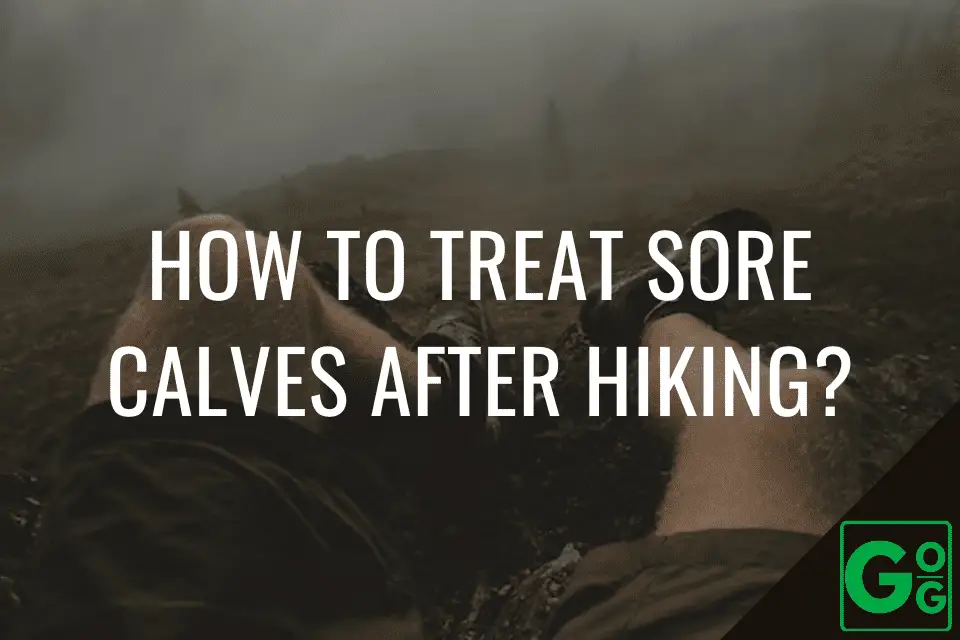We support our blogging by participating in affiliate programs. We may receive a small commission if you click through a link in this post and purchase something you need, however, this will have no impact on the price you pay for the item. Learn more about it on the Disclosure page.
If you’re an avid hiker, you know the feeling all too well. You’ve been out on the trail for hours, and your calves are screaming at you. The next day, they’re even worse. So how do you treat sore calves after hiking? In this guide, I will answer this question and provide some tips on how to strengthen your calves for hiking.
Key Takeaways:
- The best way to treat calves after a long hike is to soak them in cool water and massage them
- A proper warmup and cooldown will help to reduce the likelihood of your calves becoming sore

How to Treat Sore Calves After Hiking?
One of the most common complaints after a day spent hiking is sore calves. There are a few things you can do to ease the pain and help your muscles recover.
First, try soaking your legs in cold water for 10-15 minutes. This will help reduce inflammation and pain. You can also massage your calves with a tennis ball or foam roller. Be sure to warm up before your hike and stretch afterwards.
If your soreness persists, you may have developed a more serious injury such as Achilles tendinitis or shin splints. These require rest and ice, as well as professional treatment from a physical therapist or doctor.
Can You Hike on Sore Calves?
Yes, you can hike on sore calves, but it may not be the most comfortable experience. Here are a few things to keep in mind if you decide to hit the trails with sore calves.
First, consider how far you want to hike. If you’re looking at a long trail, it’s probably best to rest your calves and try again another day. However, if you’re planning a short hike, you can probably push through the discomfort.
Second, take it easy on yourself. Don’t try to go too fast or too far. Listen to your body and take breaks when you need them.
Finally, be prepared for some discomfort. Sore muscles are never fun, but they’re even less fun when you’re miles from civilization. Make sure you have supplies like painkillers and extra water in case your calves start acting up on the trail.
How Long Does It Take for Sore Calves to Heal?
Sore calves are a common occurrence for many athletes, especially runners. The good news is that with proper care, most cases of sore calves will heal within a week or two. However, there are some instances where the soreness can linger for several weeks.
If you’re dealing with sore calves, the first thing you should do is rest. This means taking a few days off from running or any other strenuous activity. You may also need to ice the area for 20 minutes each day and take over-the-counter pain medication if the soreness is severe.
Once the pain starts to subside, you can slowly start to increase your activity level. Begin with short walks or light jogging and gradually build up to your normal routine. If the soreness returns or gets worse, stop what you’re doing and rest until it subsides again.
Do Bananas Help with Muscle Recovery?
Bananas are often considered a go-to food for athletes, but there is some debate as to whether or not they actually help with muscle recovery. While bananas contain potassium, which is essential for muscle function, they also contain sugar and calories.
There is no denying that bananas are a nutritious food packed with vitamins, minerals, and antioxidants. However, there is little scientific evidence to support the claim that they help with muscle recovery. One study found that banana consumption did not improve markers of muscle damage or inflammation after exercise.
So, while eating a banana after a workout won’t hurt, don’t expect it to miracle for your muscles. There are other foods that are better supported by research when it comes to aiding in muscle recoveries, such as protein-rich foods and omega-3 fatty acids.
Will Hiking Tone My Legs?
Hiking is a great way to tone your legs. It is a low-impact activity that can be done by people of all ages and fitness levels. hiking can be done on trails of varying difficulty, so you can find one that suits your needs.
Hiking is a great workout for your legs. It targets all the major muscles in your legs, including your quads, hamstrings, and calves. The inclines and declines of hiking also help to tone your leg muscles.
So, if you are looking for a way to tone your legs, hiking is a great option. It is an enjoyable activity that has many benefits for your overall health and fitness.
How Do You Strengthen Your Calves for Hiking?
If you love hiking, you know that having strong calves is a must. But how do you strengthen your calves for hiking?
There are a few things you can do to get stronger calves. First, try calf raises. You can do these by standing on a step and raising your heels so that you’re standing on your toes. You can also add weight to make it more challenging.
Another great way to strengthen your calves is to walk or run uphill. This will work your calf muscles more than walking on level ground.
Finally, try doing some yoga poses that focus on strengthening the calf muscles. Warrior III is a great pose for this. Start in mountain pose and then lift one leg behind you while reaching your arms out in front of you. Hold for a few breaths and then switch sides.
Summary
So there you go, treating sore calves after a hike can be done by stretching, massaging, and using cold or heat therapy. It is important to find what works best for you and to listen to your body. If the pain persists, it is best to see a doctor.

